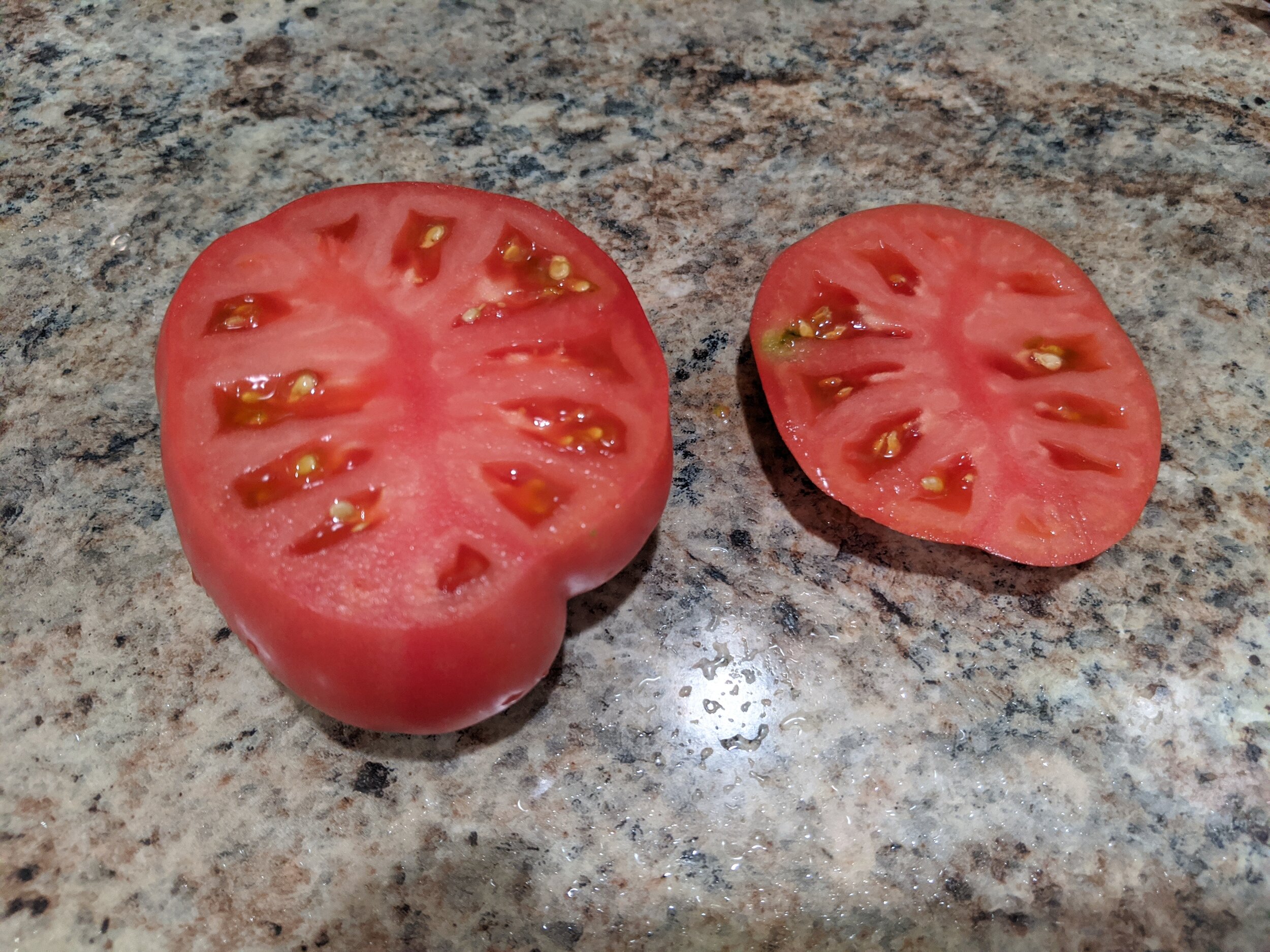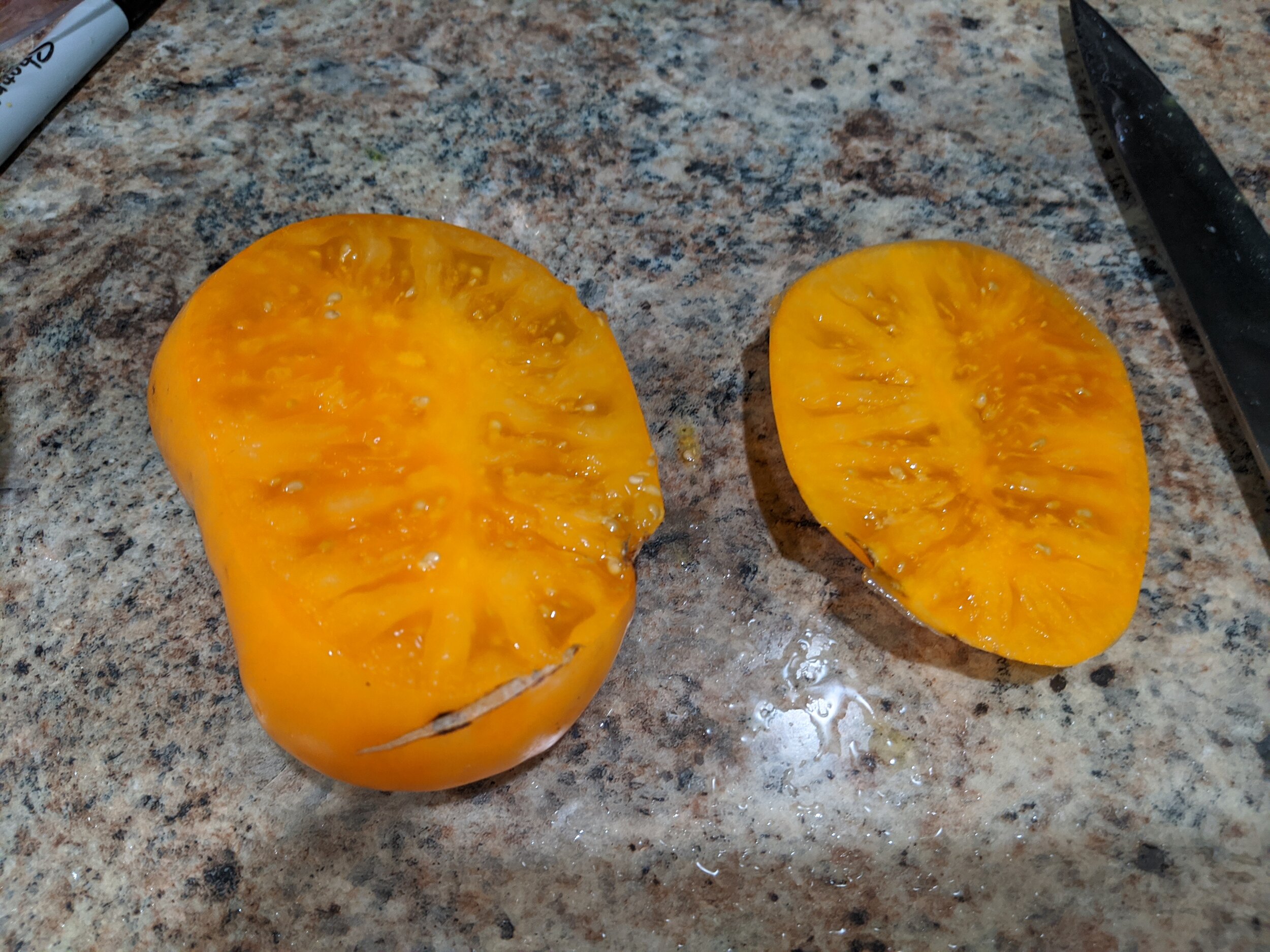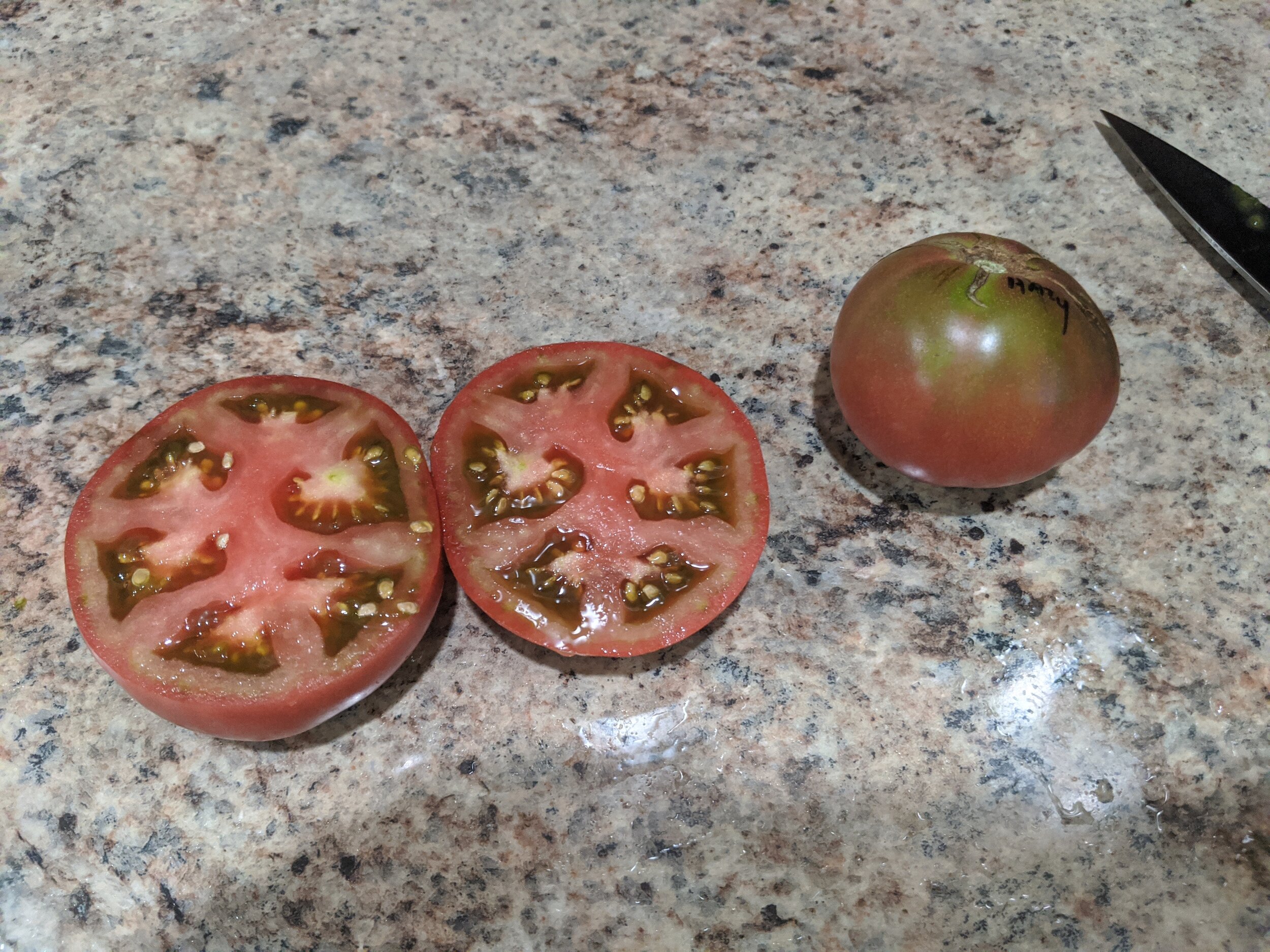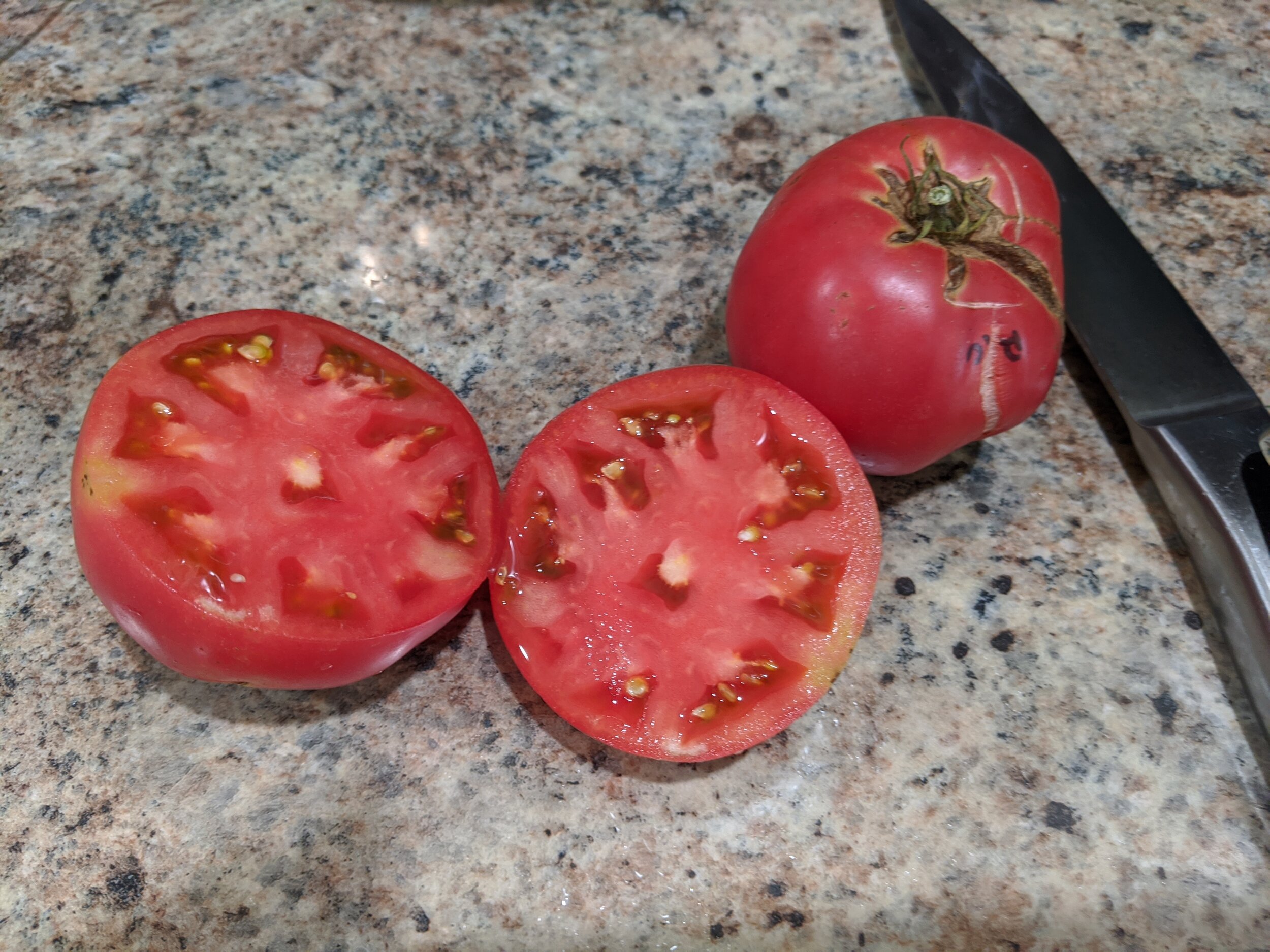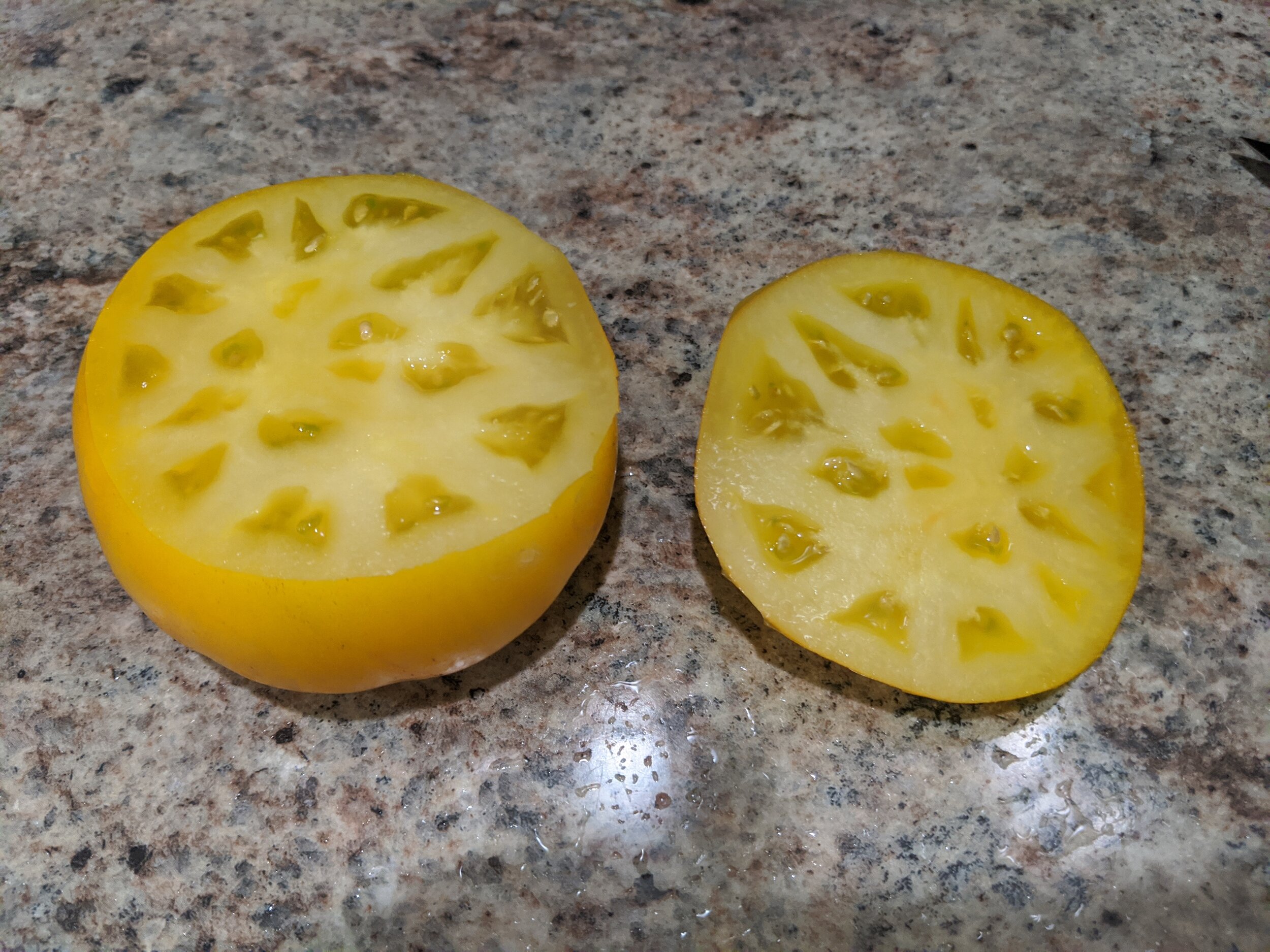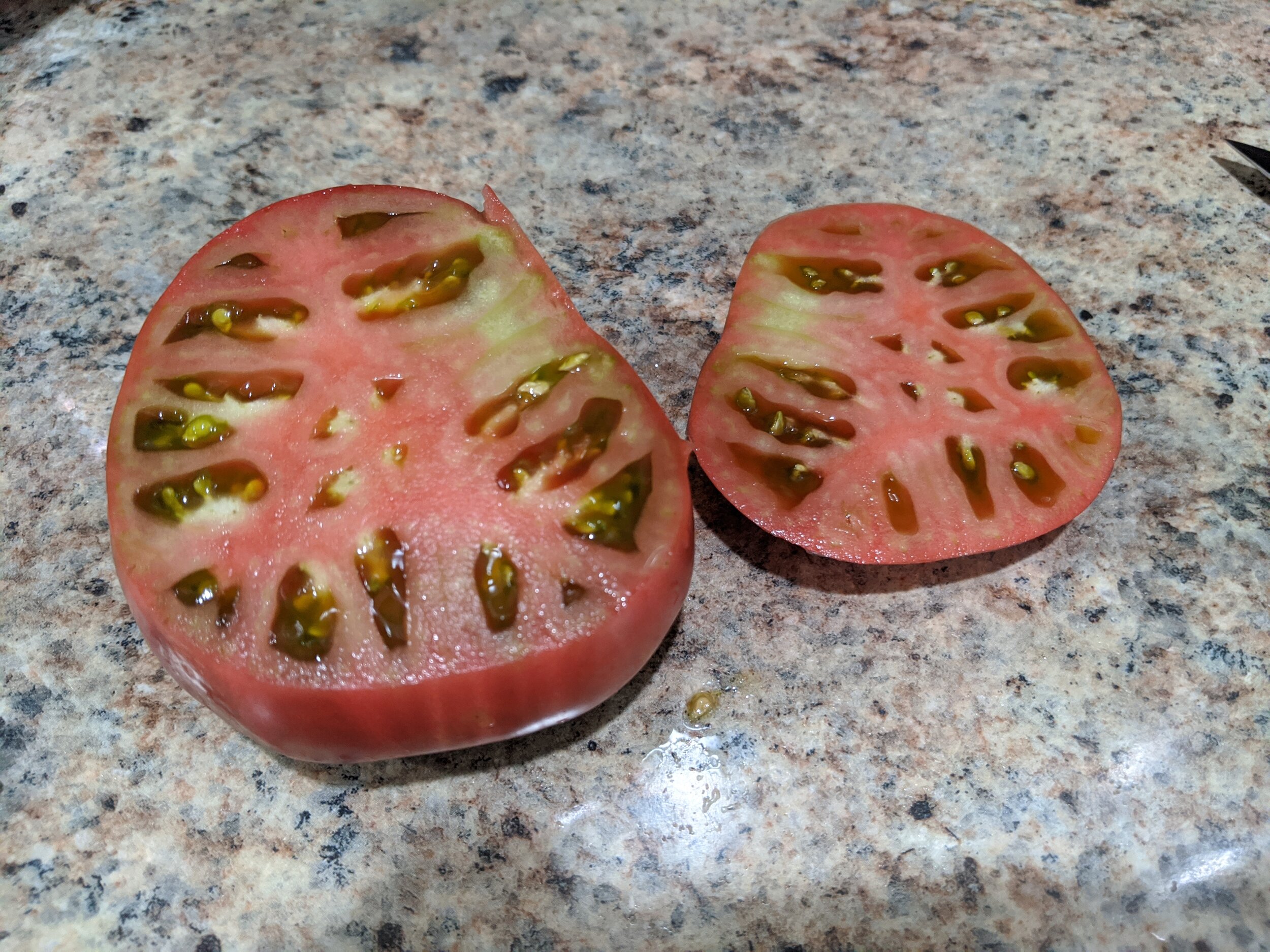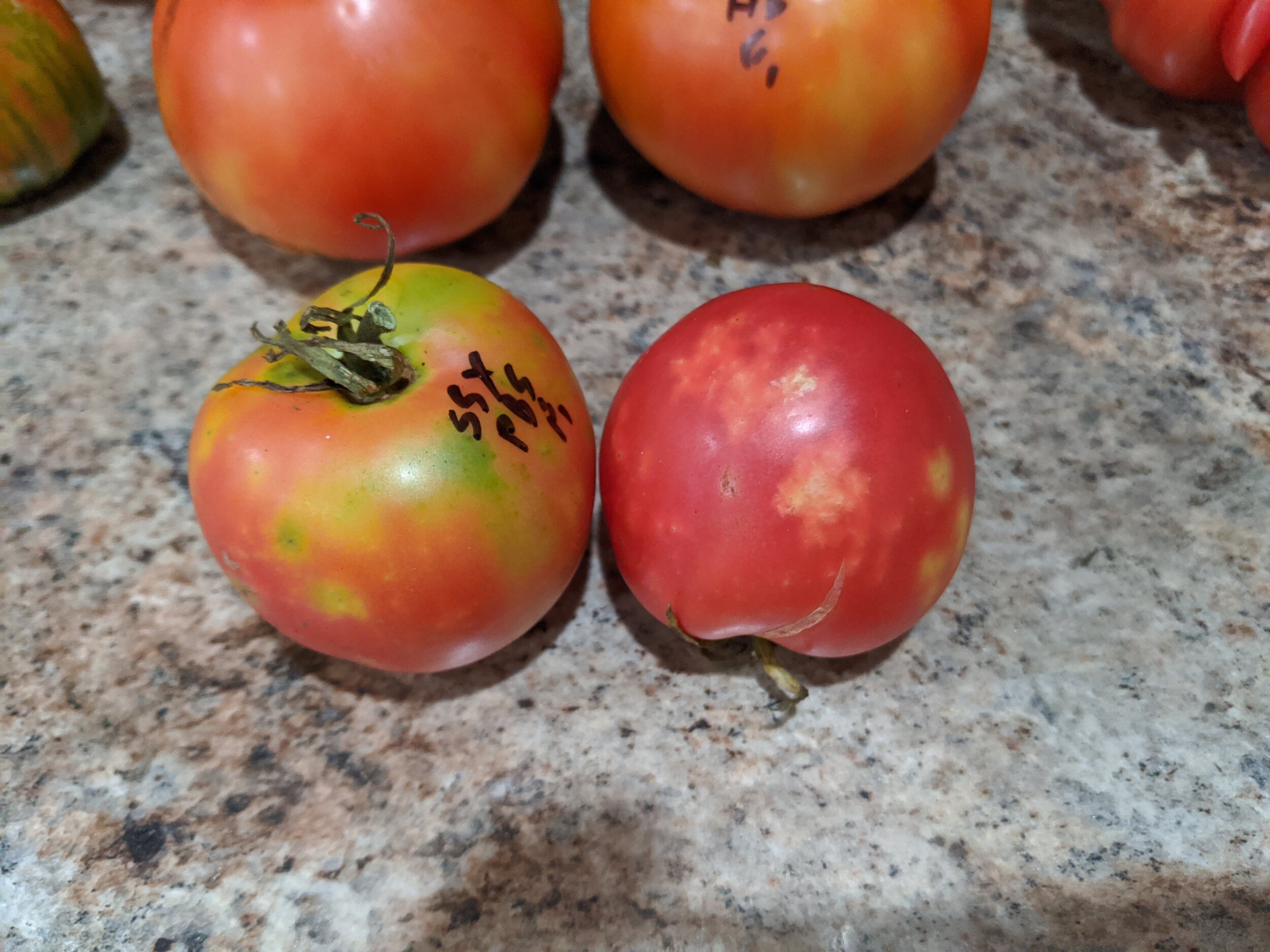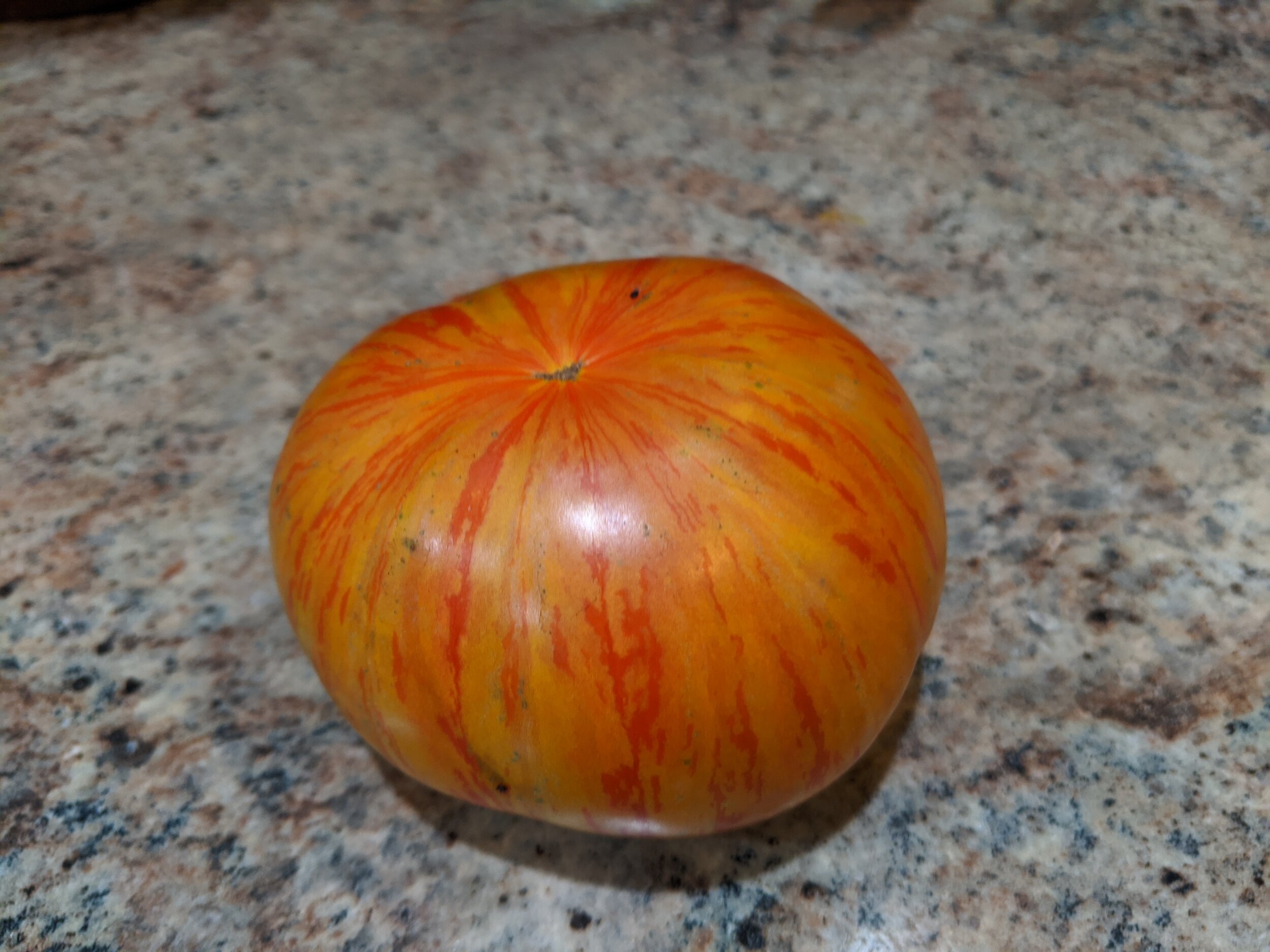Now it is time to dig into my work on the various yet-to-be-released, Dwarf Tomato Project varieties in development. Deciding what to work on is always a challenge - we’ve accomplished so much, yet so much remains to play with!
I will start to candidates with names, then go to general families, which contain yet to be named possibilities. - there are 12 of these
Dwarf Tanager - a lovely bright orange tomato
Dwarf Tanager - planted 6866, F7 generation seed, which is from 6810, which is from 6259, which is from 5104, which is from T13-82, which is from T12-186, which is from 3536, Fancy F1, created by Sherry Long by crossing a Sunny orange fruited selection with Orange Pear. It is a very complex family with lots of different colors from our work. My saved seed from this year is T20-37, F8 generation seed.
Orange tomatoes are always welcome, particularly if they have outstanding flavor. We have Dwarf Perfect Harmony (from the Harmony family), Loxton Lad and Loxton Lass from the Rosy family, and Dwarf Blazing Beauty and Dwarf Orange Cream from the Tipsy family. Dwarf Tanager seems to about ready for release and will be a nice addition. It is a nice looking potato leaf dwarf with medium to medium large, smooth oblate bright orange tomatoes, and orange flesh. Mike at Victory has the latest generation, so it could be soon, or may be next year. My plant got off to a good start, but was in the part of the driveway that was a bit sun starved. It ripened quite late for me and disease and worm damage was beginning to go a bit out of control. The little I got to taste was excellent, a solid 8 out of 10.
Dwarf Strawberry Lemonade - this will be a great addition to our pink dwarf releases
Dwarf Strawberry Lemonade - planted 6864 (F6 generation), which is from 6802, which is from 6271, which is from 4644, which is from T12-186, which is from 3536 - Fancy F1. Seed I saved this year, F7 generation, is T20-39.
There is a bit of instability remaining in this one - I got what was expected, but Mike saw some variation in color. It was another variety that was in a somewhat poor location in my yard, but despite this, yielded heavily, was of really nice size, and tasted delicious - perhaps a bit better than 7.5. The pink tomatoes were oblate, quite meaty, on the sweet side and were medium to medium large in size. We are fortunate to have some really fine pink colored tomatoes coming from our project.
round version of dwarf Mocha’s Cherry
plum shaped Dwarf Mocha’s Cherry, not yet ripe, showing strong antho
The two shapes of Dwarf Mocha’s Cherry, round on left, plum on right, showing ripe purple color with the strong antho shading
Dwarf Mocha’s Cherry - planted T19-155, F4 generation, which is from T18-72, which is from T17-62, which is from T16-160, which is Anthy F1 - Saucy Mary X an antho pink cherry, crossed by me. I grew three plants from T19-155. All were purple small fruit with significant antho on the shoulders making the tomatoes look dark bluish black. The foliage had violet shading as well. Two of the plants gave small elongated oval tomatoes, and one was nearly round. The two oval selections are saved as T20-47 and T20-48, and the round selection is saves as T20-84, all F5 generation seed. It is not the best flavored series, but when totally ripe they are in the 7 range to my palate. They are gorgeous and prolific!
Mike at Victory also grew out this seed lot of Dwarf Mocha’s Cherry and observed more uniformity that I did - he also loved the flavor. For me, both T20-47 and T20-48 were quite compact in height - among the shortest of the tomatoes from our project. The round one, T20-84, was super prolific and gorgeous, ripening to purple with the heavy black blue antho shoulders. The round one will end up being Dwarf Mocha’s Cherry, and the elongated one Dwarf Mocha’s Plum (at least that’s my plan!).
Dwarf Idaho Gem - planted 6867 F6 generation, which is from 6805, which is from 6270, which is from 4644, which is from T12-186, which is from 3536, Fancy F1. I saved seed as T20-73, F7 seed.
This one certainly struggled - poor location, disease, late fruit set, then blossom end rot and worm damage. I managed to pick 2 medium sized oblate fruit when still quite green - it ripened to a bright yellow, but I didn’t taste it. Mike has seed of this and found continuing variability. When that is fixed, we will have a nice yellow - I consider this to be a regular leaf “cousin” to Dwarf Goldfinch, out of the same family.
Dwarf Laura’s Bounty - planted 6403, F7 seed, which is from 6180, which is from 5866, which is from 5650, which is from 5335, which is from T12-41, which is from 3534 - Leggy F1. Saved seed from this year is F8 generation, T20-77.
This is another stubborn variety. Last year I grew it, the color was correct (bright orange), and deer ate all of the fruit and stunted the plant - no seed saved. This year the plant looked great, it produced well….but it was a fat pink medium sized tomato - it showed as Dwarf Melanie’s Ballet, from the same family. We are back to the drawing board with this one.
enormous potato leaf foliage in Worry family potato leaf selection
Dwarf Modern Roman - planted 6903, F6 seed, which is from 6604, which is from 6136, which is from 5774, which is from T15-128, which is from T15-94, Worry F1, my cross between Speckled Roman and Wherokowhai. Saved seed is F7 generation T20-89.
Here we have another stubborn variety that is proving to be a bit of a challenge to bring to stability. The goal is a solid scarlet red paste tomato, size and shape of one of the parents, Speckled Roman. What I ended up with is the version that looks exactly like Speckled Roman, which is Stony Brook Speckled. The result shows the challenge of eliminating stripes in varieties where there is a striped parent. Once we get this one right, it will be a great addition to our project, with huge gorgeous potato leaf foliage.
Dwarf Kodiak King - planted 7058, F6 generation, which is from 4326, which is from T09-95, which is from 2530, which is from T08-2, which is from 2183, which is Grizzly F1, created by Patrina by crossing New Big Dwarf with Grozny 91. Saved seed from this year is F7 generation T20-90.
It is good to see Grizzly family releases finally reaching completion. Dwarf Snakebite is a nice medium large pink that is now available and was described in my previous update blog. Kodiak King is the red selection. It struggled for me, flowering quite late and the fruit suffering from late season worm attack. I did manage to pick a few partially green tomatoes that ripened scarlet red, so seed saving happened, but tasting and photography did not. It is ready to send along to Mike for commercial release in the next year or two.
Dwarf Stony Brook Speckled - planted 6899, F6 generation, which is from 6605, which is from 6136, which is from 5774, which is from T15-128, which is from T15-94, Worry F1, my cross between Speckled Roman and Wherokowhai. Saved seed is F7 T20-109.
This is a fine variety, producing lots of Speckled Roman colored, flavored, shaped and sized fruit on a potato leaf dwarf. It is ready to send on to Mike at Victory for eventual release. It will be good to get some additional, nice sized paste varieties in our project release roster.
Dwarf Stony Brook heart - a nice potato leaf partner to Dwarf Speckled Heart (regular leaf, different family)
Dwarf Stony Brook Heart - planted 6901, F6 generation, which is from 6607, which is from 6137, which is from 5774, which is from T15-128, which is from T15-94, Worry F1, my cross between Speckled Roman and Wherokowhai. Saved seed is F7 T20-91.
Dwarf Ann’s Dusky Rose Plum - planted T19-56, F4 generation, which is from T18-58, which is from T17-49, which is from T16-160, which is Anthy F1. I planted two plants, one of which showed more antho in the foliage. One plant produced pink paste with no antho saved as F5 generation T20-80, and one plant produced deep pink past tomatoes with significant antho on the shoulder, saved as F5 seed T20-93. One issue with this line has been seedlessness of some of the better tasting selections. The one most worth pursuing will be T20-93, the purple/pink plum with antho.
Dwarf Gloria’s Treat - yummy heart shaped bicolor
Gloria’s Treat showing shape and interior, front left
Dwarf Gloria’s Treat - planted 6979, F6 generation, which is from 5276, which is from 4380, which is from T12-141, which is from 3422, which is from 3468, which is Ivalde F1. Seed from this year is saved as T20-95, F7 generation seed.
The Ivalde family is such fun - there are 8 distinct color/leaf type/fruit shape combinations. Dwarf Gloria’s Treat is the potato leaf, heart shaped, yellow/red bicolor version. It was one of the absolute best of my Dwarf Project plants from last year, and I feel that it is ready to send to Mike at Victory for release within the next year or so. Fruit size is medium to medium large, productivity and plant health is excellent, and the flavor is really superb - at least an 8 out of 10.
Dwarf Liz’s Teardrop
Dwarf Liz’s Teardrop - I planted two leads for this challenging, stubborn variety (due to many of my attempts being seedless!) - T16-24, F3 generation, and 6597, F5 generation. Both of these do intersect - 6597 is from T17-66 which is from T16-24, which is from 5748, which is from T15-95, Steamy F1, created when I crossed Sungold hybrid with Dwarf Pink Passion. Seed saved from T16-24 is F4 seed T20-101, and from 6597 is F6 generation T20-100.
I was pleased that there were sufficient seeds in fruit of each selection grown to proceed next year. Both showed the desired small teardrop shape. Productivity is amazing, flavor is very good - on the sweet side, in the 7 to 7.5 range. Since T20-100 is a more advanced generation, that is the one to move forward with.
Finally are broader Dwarf families that we are selecting from - there are 7 of these
front right in this pic shows one of the Scotty yellow leaf potato leaf plants
Ripening fruit from Scotty T19-51 normal color regular leaf with delicious large pink blunt hearts with gold stripes
Ripe Scotty T19-51 reg color regular left, at the right, showing pink with gold stripes - also in the bowl are Dwarf Liz’s Teardrop (in front of the Scotty), and Dwarf Chocolate Heartthrob (front), and Dwarf Moby’s Cherry (in the center)
Scotty family - I planted a number of these - T19-51, T19-52 and T19-53. Scotty T19-51, F4 generation, is from 6702, T19-52, F4 generation, is from 6702, and T19-53, F3 generation, is from 6697. 6702, is from T17-58. 6697 is from T16-161. T17-58 is from T16-161. T16-161 is Scotty F1, which I created by crossing Surprise with Dwarf Scarlet Heart. I ended up planting four plants from T19-51, and one each from T19-52 and T19-53.
The four plants from T19-51 are potato leaf normal color, saved as T20-49, yellow leaf regular leaf, saved as T20-52, potato leaf normal color, saved as T20-62, and regular leaf normal color, saved as T20-75. T19-52, potato leaf yellow leaf, is saved as T20-64. T19-53, potato leaf yellow leaf (check this), is saved as T20-82.
As far as the T19-51 source plants, the best by far is T20-75, a very prolific, quite early variety with medium to medium large heart shaped pink tomatoes with gold stripes - flavor is a solid 8. The foliage is regular leaf, normal color. T20-49 is a good sized pink oblate, quite early, prolific - and as large as 8 ounces, pink with faint stripes. It ranked 7.5 in flavor. It has potato leaf, normal colored foliage. T20-52 has regular leaf, yellow colored foliage, fruit went from white to pink, heart shaped, flavor not recorded or tried due to its poor location and late season fruit damage by worms. T20-64 has yellow colored potato leaf foliage, and the heart shaped fruit ripened white to pink, flavor 7.5.
The T19-52 plant, saved as T20-62, was normal color potato leaf plant with medium sized pink slight hearts with faint stripes, flavor 7.5 - it was very similar to T20-49.
The T19-53 plant, saved as T20-82, was a yellow foliage colored potato leaf plant with medium to medium large oblate fruit that ripened from white to scarlet, with a flavor of 7.5.
The mail question is in, aside from the large pink gold striped delicious heart, what to pursue. I’d like to get a yellow leaf variety released, but the flavor could be better. It is also a bit alarming for gardeners to see the yellow foliage, and many who have worked on this line fear that the plants are diseased!
Dwarf Chocolate Heartthrob - upcoming release from the Hearty family
Hearty family - I focused on a chocolate with stripes lead, 4936, which is an F3 selection from the Hearty family sent to me by Vince Lavallo. Hearty was created by crossing Berkeley Tie Dye Heart with Dwarf Purple Heart. I grew two plants, and F4 seeds were saved as T20-50 and T20-65, both F4 generation. The tomatoes were identical on each plant. Fruit size is medium, the plants are prolific and very tasty - chocolate with green stripes. This one will go to Mike D at Victory for grow out and hopefully release within the next year or so, as Dwarf Chocolate Heartthrob.
Another view of one of the Acey variegated potato leaf selections
Acey dwarf showing variegated foliage
Acey family - I planted two different vials - 6939 and 6941, both F4 generation selections named Michelle’s Ace by the project volunteer who selected them and sent me seeds. Both were reported to have regular leaf variegated foliage, with 6939 saladette size, 6941 oblate and larger, up to 4 ounces. Both came from 6385, which is from T16-101, which is from T15-118, Acey F1, which I created when crossing Variegated with Dwarf Mr. Snow. I found regular and potato leaf seedlings in each planting and grew one of each - so a potato leaf and a regular leaf (both variegated) from 6939, and a potato leaf and regular leaf from 6941 - four different Acey project plants.
6939 seedlings: The potato leaf variegated plant was saved as T20-67, and the regular leaf variegated as T20-105. Health on both were excellent, productivity high. T20-67 produced medium sized oblate ivory colored fruit with a flavor of 8 - essentially Dwarf Walter’s Fancy. T20-105 produced 2 ounce pale yellow fruit with a flavor of 8, very round - and being a regular leaf selection is worth pursuing as Dwarf Michelle’s Ace.
6941 seedlings: The potato leaf variegated plant was saved as T20-76, and the regular leaf variegated as T20-63. Health on both were excellent, productivity high. T20-76 produced medium small pale yellow round fruit, flavor 8 - essentially this is Dwarf Pico’s Pride, just released by Victory. T20-63 produced the same type of fruit - and is also a candidate for Dwarf Michelle’s Ace.
We now need to explore different colors in this line, as both scarlet red and pink have been observed in various selection work.
mini beefsteak shape seen in Teensy pink selection grown in 2020
Teensy family - I planted a pink selection 6890 (F6 seed), which is from a Raleigh dwarf project participant, Ann. I am sure that Ann grew 6613, which is from another dwarf project participant, Justin, JS18-3, an F4 generation. The Teensy family was created when I crossed Summertime Green with Mexico Midget. We are working on various colored cherry tomatoes from this family, with the yellow one the most advanced to date. My plant from 6890 gave an enormous crop of small fruited pink tomatoes that ranged from round to oblate to actual mini beefsteak. Alas, the flavor was not what I hoped for, rating 6.5. This is not really worth pursuing; there are better pink colored selections that need to be progressed.
Sandy family - I planted vial 7000 (F3 seed), which is from T16-97, which is from T15-110, Sandy F1 - a family I created when crossing Variegated with our release Dwarf Sarandipity. My result this year was a regular leaf variegated leaf dwarf bearing lots of chocolate colored, slightly oblate 2-3 ounce saladette tomatoes with vertical greenish stripes. The flavor wasn’t spectacular (I rated it 6.5), but in essence this is a variegated “version” of Dwarf Sarandipity. The F4 seeds are saved as T20-87. It is a pretty tomato and is worth working on for improved flavor in future grow outs.
working name Dwarf Oriole for this regular leaf, large fruited Fancy selection
Fancy family - I planted seeds of a promising, interesting find from last year - a regular leaf very large pale orange selection from the Fancy family that had a blushing rosy center. Seeds were saved as T19-143 an F4 selection - which came from T13-71, which is from T12-186, which is from Fancy F1, which is 3536. Fancy is a very diverse family, made by crossing a Sunny orange selection with Orange Pear, by a Tomatoville member, Frozengirl. Seeds are saved as T20-102, which is F5 generation. We have lots of releases and works in progress in the Fancy family - Dwarf Emerald Isle (still in progress), Dwarf Goldfinch (released), Dwarf Grinch (released), Dwarf Parfait (released), Dwarf Idaho Gem (still in progress), Dwarf Strawberry Lemonade (still in progress), and Dwarf Sunny’s Pear (released) - heart shaped, pear shaped, round and oblate, regular and potato leaf, flesh colors of green, green with orange, yellow, orange, and pink so far. The plant this year was vigorous, healthy, heavy setting - tomatoes were up to very large, pale orange with a rosy center, and delicious - this will become Dwarf Oriole (working name).
Interesting coloring of the fruit from Beauty T19-50.,showing both stripes and mottling
Interior color of T19-50
Beauty T19-59 - light and dark green stripes
Beauty T19-59 internal color
Beauty family - I continue to work on additional green fleshed Beauty selections (the single release to date is Dwarf Beauty’s Kiss, which is mottled green with purple). I planted T19-50 and T19-59. T19-50 (which is F5 generation seed) is from T11-152, which is from 3088, which is from 2731, Beauty F2. T19-59 (F6 generation) is from T12-179, which is from 3366, which is from 3088, which is from Beauty F2 2731.
T19-50 produced F6 seed that is labeled T20-78. The productive, healthy plants produced medium large oblate fruit that had light and dark green stripes, some purple mottling in the flesh, and a very good 7.5 flavor score. T19-59 produced F7 seed that is T20-68. The healthy, productive plant produced medium large, smooth oblate fruit that were light and dark green striped and also had a flavor rating of 7.5. I wish I paid a bit more close attention in terms of comparison to Dwarf Beauty’s Kiss - however, both of these seemed to be more distinctively striped and are worth further exploration. What I am trying to do is find a super delicious large light and dark green stripe that were T11-152 and T12-179. These are fun to work with!
Well, that’s all folks - I am not happy with my photography this season, particularly on the experimental dwarf varieties. I did go through my pics again and added quite a few to the above on Dec 20 AM.



